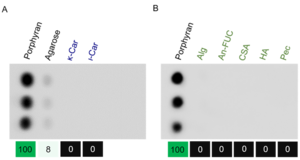CAZypedia needs your help! We have many unassigned GH, PL, CE, AA, GT, and CBM pages in need of Authors and Responsible Curators.
Scientists at all career stages, including students, are welcome to contribute to CAZypedia. Read more here, and in the 10th anniversary article in Glycobiology.
New to the CAZy classification? Read this first.
*
Consider attending the 15th Carbohydrate Bioengineering Meeting in Ghent, 5-8 May 2024.
Carbohydrate Binding Module Family 99
This page has been approved by the Responsible Curator as essentially complete. CAZypedia is a living document, so further improvement of this page is still possible. If you would like to suggest an addition or correction, please contact the page's Responsible Curator directly by e-mail.
| CAZy DB link | |
| http://www.cazy.org/CBM99.html |
Ligand specificities

The first characterized member in the CBM99 family is FvCBM99 [1]. The CBM FvCBM99 bound to porphyran and displayed a weak affinity to agarose (Fig. 1). It was incapable of binding to the other examined polysaccharides, including κ-carrageenan, ι-carrageenan, alginate, sulfated fucan, chondroitin sulfate A sodium salt, hyaluronic acid, and pectin. Furthermore, FvCBM99 bound to porphyran tetrasaccharide with an affinity constant of 1.9 × 10-4 M, but not to agarose tetrasaccharide. Since agarose chains usually contain a few characteristic structural units of porphyran [2], it was thus speculated that the weak affinity of FvCBM99 to agarose was attributed to the structural heterogeneity of agarose. The polysaccharide and oligosaccharide binding assays show that FvCBM99 specifically binds to the major structural units of porphyran.
Structural Features
The predicted structure by AlphaFold2 shows that FvCBM99 displays a typical β-sandwich fold.
Functionalities
To evaluate the feasibility of FvCBM99 as a tool in the in situ investigation of porphyran, a fluorescent probe was constructed by fusing FvCBM99 with a green fluorescent protein. The in situ visualization of porphyran in red alga Porphyra haitanensis was realized by utilizing the fluorescent probe [1].
Most of the members of the CBM99 family are appended to the GH16_11, GH16_12, GH16_16, and GH16_26 subfamily, or the GH86 family. As documented in the CAZy database, members of the four subfamilies and the GH86 family exhibit enzymatic activity for degrading porphyran. It suggests that multiple porphyran-binding CBMs might be present in the CBM99 family. Furthermore, the homologs of FvCBM99, including WP_102755601.1 (located from 770 to 859 amino acids) and WP_108602097.1 (located from 720 to 822 amino acids), were shown to bind to porphyran.
Family Firsts
- First Identified
- The first member FvCBM99 is a component of a potential GH86 porphyranase (GenBank: AJW82063.1) from a marine bacterium Flammeovirga sp. OC4 [3].
- First Structural Characterization
- No three-dimensional structure has been solved in this CBM family.
References
- Mei X, Zhang Y, Liu G, Shen J, Han J, Xue C, Xiao H, and Chang Y. (2023). Characterization of a novel carbohydrate-binding module specifically binding to the major structural units of porphyran. Int J Biol Macromol. 2023;253(Pt 5):127106. DOI:10.1016/j.ijbiomac.2023.127106 |
- Chi WJ, Chang YK, and Hong SK. (2012). Agar degradation by microorganisms and agar-degrading enzymes. Appl Microbiol Biotechnol. 2012;94(4):917-30. DOI:10.1007/s00253-012-4023-2 |
- Liu Y, Yi Z, Cai Y, and Zeng R. (2015). Draft genome sequence of algal polysaccharides degradation bacterium, Flammeovirga sp. OC4. Mar Genomics. 2015;21:21-2. DOI:10.1016/j.margen.2015.02.001 |